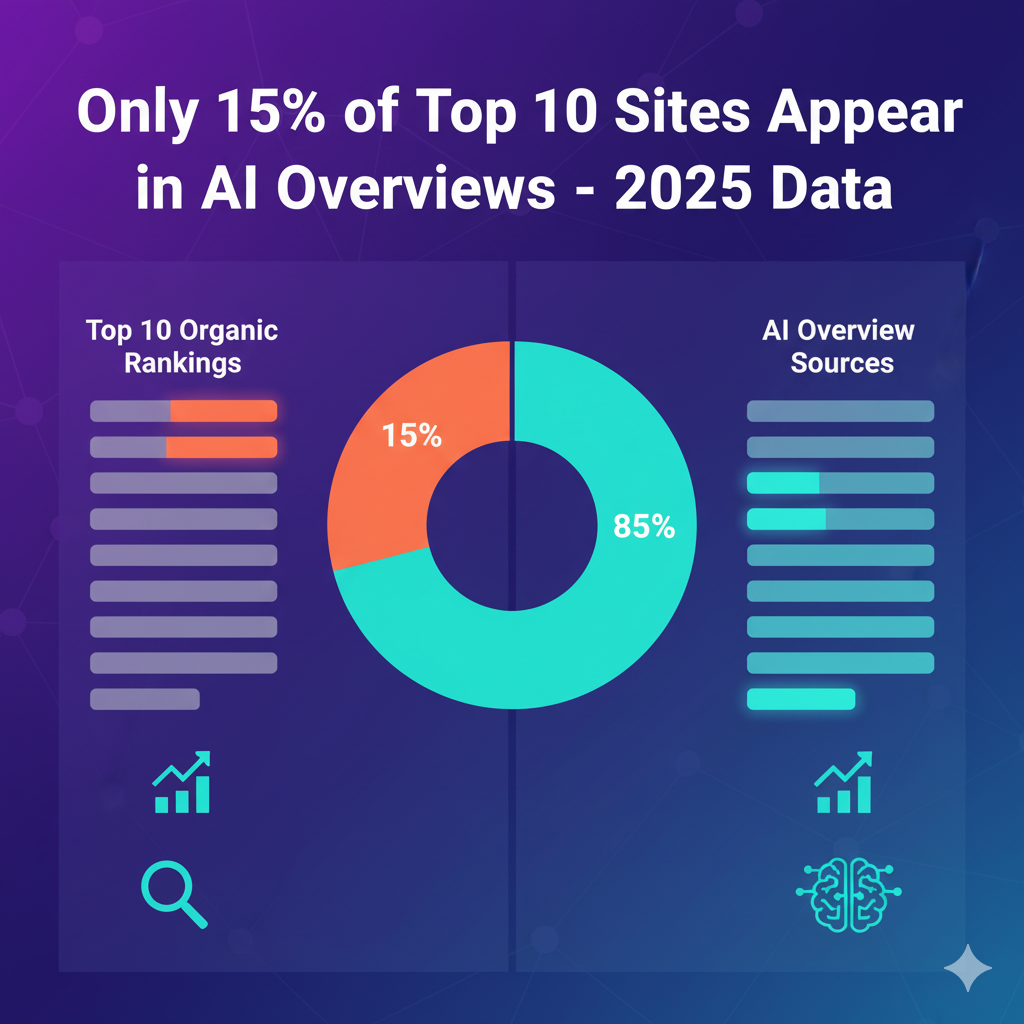Introduction
Many website owners believe that if their site ranks in the top 10 organic results on Google, they are guaranteed visibility. But with Google’s new AI Overviews (AIO) feature, things have changed.
A recent study shows that only 15% of the sources included in AI Overviews overlap with the top 10 organic search results. In other words, even if your website ranks on page one, there is an 85% chance it will not be referenced in Google’s AI-generated summary.
This article explains what this statistic means, why it matters for SEO, and what practical steps you can take to improve your chances of being included in AI Overviews.
The Stat Explained
When a user searches on Google, they may now see an AI Overview at the top of the results page. This section is automatically generated by Google’s AI and is designed to summarize the answer in a clear and concise way. To support the answer, the AI uses sources from across the web.
Here’s the important point: research shows that only 15% of those sources are websites already ranking in the top 10 organic results. That means:
- 15% of sources come from websites in the top 10 organic positions.
- 85% of sources come from websites outside the top 10.

Why This Matters
This statistic has important implications for SEO. Let’s break it down.
1. Ranking in Top 10 ≠ Being Included
Even if your website ranks in the top 10, Google’s AI may ignore your site when generating summaries. Being in the top 10 no longer guarantees that users will see your content in AI Overviews.
2. Traffic Loss and Lower Visibility
AI Overviews appear at the very top of search results. Many users read them and don’t scroll down to the organic listings. If your website is not included in the AI Overview, you could lose a significant amount of traffic—even if you rank highly.

3. Shift in User Trust
Users are beginning to trust AI Overviews as a reliable summary. When competitors are included and your site is not, users may assume other websites are more authoritative.
Practical SEO Implications
The 15% overlap number shows that the traditional way of looking at SEO—just aiming for “position #1”—is no longer enough.
Google’s AI prefers content that shows:
- Context: Complete coverage of the topic.
- Freshness: Recently updated content.
- Topical authority: Multiple articles on the same subject rather than just one.
Actionable Tips to Improve AI Overview Inclusion
1. Give Direct Answers
AI systems prefer short, clear answers. Don’t hide the key point.
- Begin sections with a concise answer.
- Use bullet points or numbered lists.
- Avoid unnecessary text—get straight to the point.
2. Build Topical Clusters
Google’s AI favors websites with expertise on a topic.
- Write multiple posts covering related subtopics.
- Connect them internally with links.
- Create a hub page linking all cluster content.
For example, if your site covers SEO, write multiple posts on “AI in SEO,” “AI and click-through rates,” “AI vs organic rankings,” etc.
3. Refresh Your Content
Fresh content has a better chance of being included.
- Review articles every 3–6 months.
- Update statistics, images, and examples.
- Republish with the latest date to signal freshness.
4. Use Structured Data (FAQ/HowTo)
Schema helps AI understand your content.
- Add FAQ schema for common questions.
- Use HowTo schema for step-by-step guides.
- Validate with Google’s Rich Results Test.
5. Monitor AI Overview Presence
You can track AI Overview appearances using:
- Search Console impressions: Monitor changes in CTR.
- Third-party SEO tools: Some track AI Overview inclusion.
- Manual checks: Search keywords in incognito mode to see if your site is included.
Real-World Example
Two websites rank in the top 5 for “best running shoes”:
- Site A: Old article, no updates, no schema, one post on the topic.
- Site B: Updated article, FAQ schema, multiple related posts, recent statistics.
Even though both rank on page one, Site B is much more likely to appear in AI Overviews. This example shows why content strategy must go beyond just rankings.
Closing Thoughts
The 15% overlap between AI Overviews and top 10 organic results shows that traditional ranking alone is not enough.
- Focus on ranking AND being included in AI Overviews.
- Update content, build clusters, and use structured data to increase your chances.
SEO now requires adapting to AI-powered search. Sites that optimize for AI Overviews will gain more visibility and traffic, even beyond traditional rankings.
Start adapting now to stay ahead, or competitors will capture the AI-driven traffic—even if you rank higher organically.

